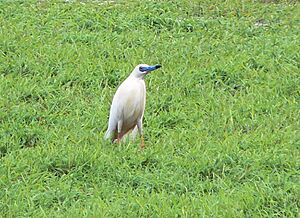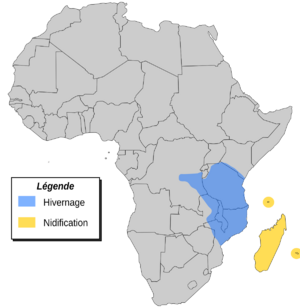Malagasy pond heron facts for kids
Quick facts for kids Malagasy pond heron |
|
|---|---|
 |
|
 |
|
| In breeding plumage (top) and non-breeding plumage (bottom) | |
| Conservation status | |
| Scientific classification | |
| Genus: |
Ardeola
|
| Species: |
idae
|
 |
|
| Yellow: Breeding range Blue: Non-breeding range |
|
The Malagasy pond heron (Ardeola idae) is a special type of heron. It's also called the Madagascar pond heron or Madagascar squacco heron. These birds live in Madagascar, Réunion, and the Seychelles islands. When it's not breeding season, they fly to eastern Africa.
Sadly, there are only about 1,300 to 4,000 adult Malagasy pond herons left. Because of this, they are considered an endangered species.
Contents
What Does It Look Like?
Malagasy pond herons are about 45 to 50 centimeters (18 to 20 inches) tall. They weigh between 250 and 350 grams (9 to 12 ounces). Males and females look quite similar. Their feathers, eyes, and bills change color depending on their age and if they are ready to breed.
Adult Appearance
Adult herons have two main looks: non-breeding and breeding plumage.
When they are not breeding, their head and back are a mix of buff and black. The rest of their body is mostly brown. Their bill is green with a black tip, and their eyes are yellow. When they fly, you can clearly see their white flight feathers.
When it's time to breed, their body turns mostly snow white. Their bill also changes to a deep blue color. After breeding, their feathers change again, with some dense plumes growing on their neck and chest.
Young Herons
Before they become adults, young herons have a special "juvenile plumage." This lasts for a few weeks after they leave the nest. Young herons have a dull orange bill and pale green eyes. Baby chicks are easy to spot because they have thick, buff-yellow down feathers.
How Do They Communicate?
Malagasy pond herons often hide in trees and bushes if people come near. This makes it hard to hear their calls. They have two main calls: a flight call and a burr call.
The flight call is short, lasting about half a second. They use it every 5 seconds to keep a safe distance from other birds while flying. The burr call is used when other herons get too close to their nest.
Where Do They Live?
Malagasy pond herons breed in Madagascar, Réunion, and the Seychelles. During the non-breeding season, they fly to eastern Africa. This includes countries like Kenya, Tanzania, Uganda, Rwanda, Burundi, DR Congo, Malawi, Zambia, Zimbabwe, and Mozambique.
In Madagascar, you can often see them in places like Lake Alarobia and Tsimbazaza Park. They live in many different wet areas. This includes small grassy marshes, lakes, ponds, streams, and even rice fields. On the Aldabra islands, they like mangroves, inland pools, and lagoon shores. They can be found from sea level up to about 1,800 meters (5,900 feet) high.
What Are Their Habits?
One important habit of the Malagasy pond heron is its yearly migration. They fly from Madagascar to eastern Africa in May and return to Madagascar in October to breed. Young herons that are not yet adults stay in Africa. They don't need to travel to the breeding areas.
These birds are very territorial. They don't like other birds getting too close. They usually stay at least 10 meters (33 feet) apart, whether they are nesting or flying. Sometimes, two herons might fight, grabbing each other's bills in the air. In Africa, it's rare to see more than two herons on the same body of water.
They usually build their nests along the coast. They look for food further inland, away from their nests. The closest they get to other herons (besides breeding) is when they roost together in their nests. Because their habitat is shrinking, they sometimes roost closer together. They might even share roosting spots with other heron species, like cattle egrets.
What Do They Eat?
We don't know a lot about what Malagasy pond herons eat. But it's believed they mostly eat fish, water insects, and small creatures without backbones. They might also eat crustaceans (like crabs), frogs, toads, snails, worms, caterpillars, and even small lizards like chameleons, skinks, and geckos.
One small study in Madagascar showed that a heron ate fish, crustaceans, frogs, dragonflies, beetles, and grasshoppers. On islands like Aldabra and Mayotte, there aren't many amphibians, so herons there can't eat frogs or toads.
Threats to Their Survival
The biggest danger to the Malagasy pond heron is the loss of its home. People are clearing, draining, and changing their wetland areas into rice fields. Also, people sometimes collect their eggs and young birds from breeding sites. This causes big problems for future generations of herons. As a result, their numbers have dropped a lot in the last 50 years. However, a new resource management plan called GELOSE is helping to protect their habitat.
Another threat is competition with the squacco heron. Squacco herons are spreading fast and seem to adapt better to changes made by humans. There are many more squacco herons than Malagasy pond herons in Madagascar. Even though they are outnumbered, the Malagasy pond heron usually wins when they interact with squacco herons.
Reproduction and Life Cycle
Malagasy pond herons breed in groups called colonies. Many birds gather in one place to mate. Sadly, the size of these colonies and the number of breeding locations have shrunk a lot in the last 30 years. Colony sizes have dropped from 700 birds to around 50. Breeding is now limited to only a few places.
In Madagascar, they build nests in phragmite reedbeds, typha, papyrus, and Cyprus plants. Coastal islands are also very important for breeding. In Madagascar, they often breed in mixed colonies with other heron species. These include the black-crowned night heron, little egret, cattle egret, great egret, and the squacco heron.
The largest colony ever recorded was about 500 pairs of Malagasy pond herons in Imerimanjaka Cyperus marsh, near Antananarivo, in 1940. These 500 pairs were mixed with 1,500 pairs of squacco herons! Today, colonies usually have fewer than 10 pairs.
Like many birds, Malagasy pond herons face predators. They build their nests in trees and bushes in hard-to-reach ponds and marshes. Their main predators are different types of crocodiles and large snakes. To protect against dangers on the ground, nests are built 1 to 4 meters (3 to 13 feet) above the ground. If they are in a mixed colony, they always choose the highest nests.
Breeding usually starts in October and can last until March if the heron lays two sets of eggs. On the coral atoll of Aldabra, breeding increases a lot when the rains arrive in November and December. Even though they live in many places, Malagasy pond herons only breed in Madagascar and Aldabra. In Madagascar, the area west of Antananarivo is a favorite breeding spot. On Aldabra, they use nature conservation sites like Ile aux Aigrettes and Ile aux Cedres.
Successful breeding often involves special courtship dances. These include aerial chases, duets (singing together), and raising their crest feathers. The eggs hatch after about 21 to 25 days. Young herons have green down feathers, which you can see about 2 weeks after they hatch. This is when they leave the nest for the first time.
Protecting the Malagasy Pond Heron
The conservation status of the Malagasy pond heron has changed a lot. In 1988, it was listed as near threatened (meaning it might become endangered soon). But because of ongoing problems, it was moved to the vulnerable category in 2000. In 2016, it was upgraded again to endangered.
The main threats are people collecting their eggs and young birds from breeding colonies. Also, their wetland homes are being destroyed. Efforts are being made to protect these special birds and their habitats.


